14. ATTEMPTS AT RECOVERY (THE 1920s)

AMERICA SEEKS "NORMALCY"
CONTENTS
 Disillusionment with "Old World" Europe Disillusionment with "Old World" Europe
 The post-war "Red Scare" The post-war "Red Scare"
 Depression in rural America Depression in rural America
 The "Roaring Twenties" The "Roaring Twenties"
 The Scopes "Monkey Trial" The Scopes "Monkey Trial"
 Participating in the world disarmament Participating in the world disarmament
movement
The textual material on page below is drawn directly from my work
A Moral History of Western Society © 2024, Volume Two, pages 125-130.
DISILLUSIONMENT WITH "OLD WORLD" EUROPE |
Americans
had not been involved in the war as long as the Europeans and what
military action had taken place had worked out fairly well for the
Americans. Consequently, America came back to a sense of triumph
that would be lacking in the European countries. However, as news
of the deals being worked out in Paris after the war reached the ears
of Americans a sense of frustration set in ... because it seemed that
the very things that Americans had sacrificed their sons for was being
ignored by America's "victorious" allies. Then even more as
workers' uprisings, inspired by Europe’s strange fascination with
socialism and communism, made the news in America, Americans felt even
all the more estranged from Europe and its politics. The "Old
World" was ignoring completely the democratic or progressivist dream
America had been holding out in hope that the war effort might bring to
fulfillment ... and thus redeem all the blood shed in a war that
otherwise had no other noble purpose. But toward such redemption
clearly was not where Europe seemed to want to go.
| Complicating
matters were several incidents involving Italian anarchists
(particularly immigrants influenced by the Italian anarchist Galleani)
that set the country on edge. Attorney General Palmer even had
his house blown up by an agitator ... determining him even more to
break this ‘Red Scare.’ Thousands were arrested in the period
November 1919 to February 1920. Then the case of a robbery and
murder in a payroll heist in April of 1920 – leading to the arrest of
two Italians with anarchist background, Nicola Sacco and Bartolomeo
Vanzetti – would absorb the attentions not only of all America but even
much of the world. They were sentenced in the summer of 1921 but
appeals dragged the case out until they were put to death six years
later ... with the country much divided over the issue.
|
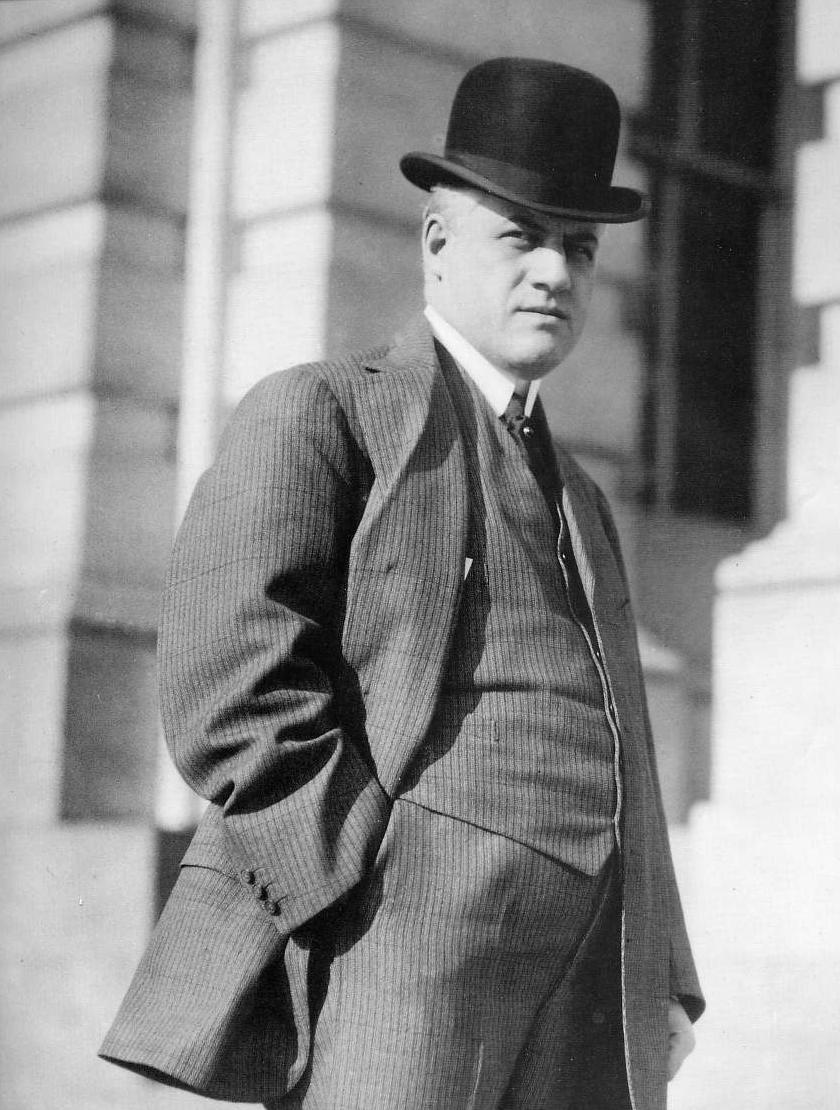
Wilson's Attorney General
Mitchell Palmer

The anarchist Wall Street bombing -
September 16,
1920
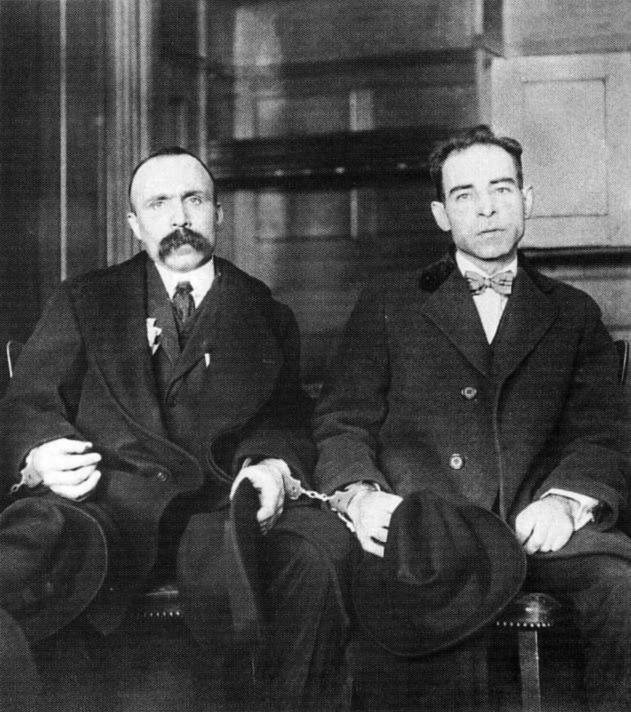 Nicola Sacco and Bartolomeo
Vanzetti
Nicola Sacco and Bartolomeo
Vanzetti
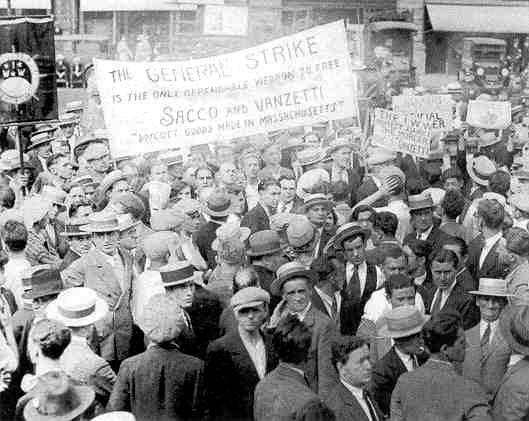 Protest in NYC over the Sacco
and Vanzetti trial - 1921
Protest in NYC over the Sacco
and Vanzetti trial - 1921
DEPRESSION IN RURAL AMERICA |
Then
too there was the growing sense among traditional rural and small-town
America that the rising urban society was corrupt and even
anti-American. Part of this was because of the huge number of
immigrants moving to urban America and carving out strongly ethnic
neighborhood where English was seldom heard. For rural America
going to the city was like going to a foreign country. It was
certainly not the America they knew.
Part of this sense of alienation from urban America was fueled by the
growing economic disparity between city and country life in
America. Farmers had prospered greatly during the war ... feeding
much of Europe at a time when most of Europe’s farmers were in uniform
fighting the war. American agricultural business was so good that
farmers took out loans and mortgages to buy more land and
equipment.
But after the war, as the European farmers returned to their fields,
the demand for American farm products dropped away. Indeed, the
oversupply of farm produce drove prices at times below even their
production costs. On top of this, those loans and mortgages had
to be paid off ... and the farmers had no money. Soon the lending
banks found themselves in trouble as well. Bankruptcies among
rural banks spread quickly around the country ... creating a rural
depression that anticipated the 1930s industrial depression in America
by ten years. Thus in the 1920s, rural America already knew
what a massive economic depression was all about.
|
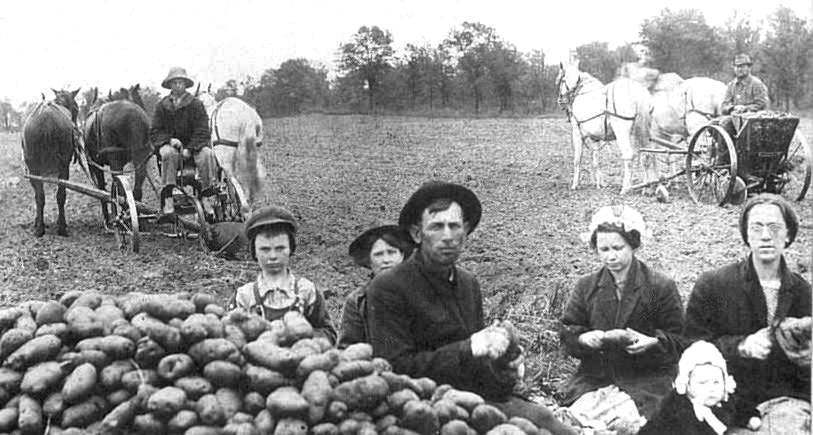 Minnesota potato farmer -
1920s
Minnesota potato farmer -
1920s
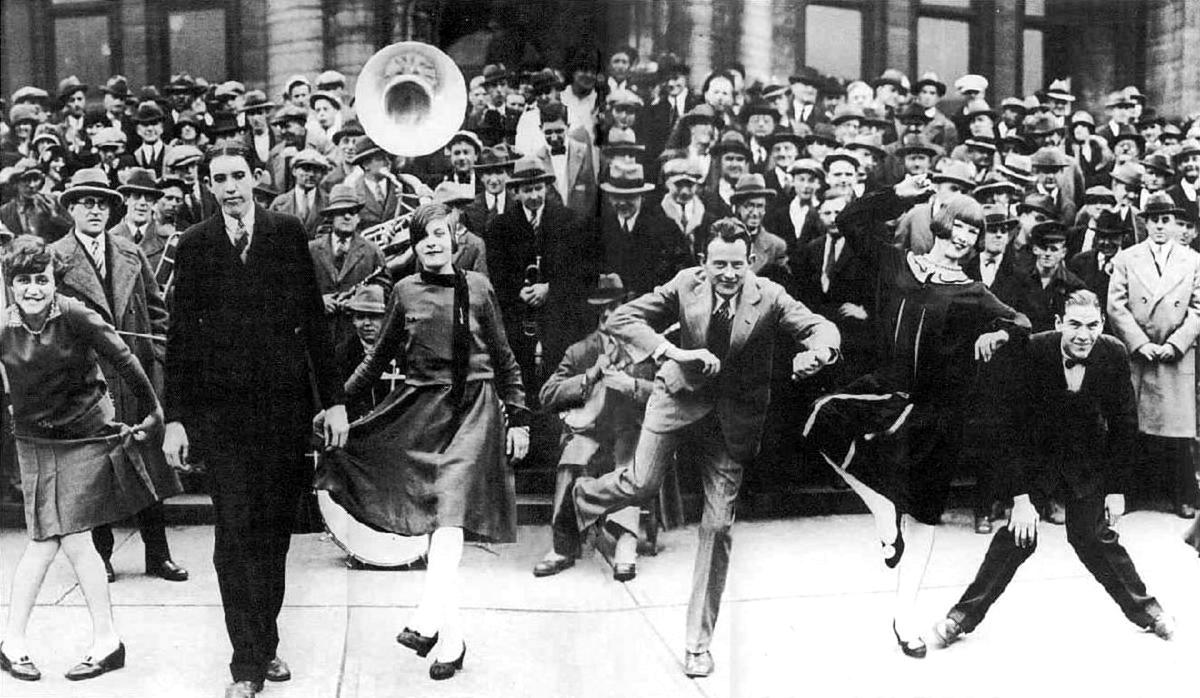
Doing the Charleston in
competition – St. Louis, 1925
Massive consumerism.
By contrast, urban America seemed almost in a partying mood.
America’s industrial war machine was easily converted after the war to
the production of a whole new line of consumer goods, which quickly
flooded the market: automobiles, radios, washing machines, vacuum
sweepers, stylish clothing, movies. For instance, by 1927, Ford had
produced over 15 million of its Model-T Fords; by 1929 the A&P
grocery stores numbered 15,000, Woolworth’s 5 & 10 cent stores
numbered nearly 2,000, and J.C. Penny department stores numbered almost
1,500; by 1930 13.8 million Americans owned radios.
New "freedoms."
Also very visible about 1920s America (particularly urban America) was
its strong emphasis that life was all about personal freedoms … rather
than heavy social responsibilities – ones such as the recent war had
required of them. No … there would now be no social rules that
would prevent them from undertaking life entirely on their own – in
whatever manner they chose to do so. Nationalism and patriotism
were things to be avoided … in order to secure the freest life
possible. Yet (unsurprisingly), there was great conformity
visible in their "free" hair styles, clothing styles, musical tastes,
etc.
Corruption in the White House.
Nonetheless the anti-social instincts also became quite visible during
the brief presidency of Warren Harding (1921-1923), corruption in the
Harding Administration (not so much in the person of Harding himself,
however) seeming almost to be the word of the day ... though his
presidency was cut short when he died of a heart attack on a visit
across the country to try to put his administration in a better light.
His
vice president Calvin Coolidge on becoming US. President did bring
something akin to Puritanical dignity back to the high office ...
though his was not exactly an activist presidency.
"The Lost Generation."
But all this freedom and glitz and glitter did little to satisfy the
burdened hearts of a number of members of America's
artistic-intellectual community. Under the patronage of Gertrude
Stein, a group she herself entitled "the Lost Generation" gathered in
Paris, in the attempt to offer each other companionship and support
(e.g., Hemingway, Fitzgerald, Dos Passos, Cummings, etc.). Others
went down the dreamy path of Marxism … with its anti-nationalism (Marx
detested the way nationalism was dividing his working-class movement) …
which was an understandable instinct given the horrors of the
nationalism-induced war the world had just gone through.
But
disillusionment did not extend just to the newly rising nationalist
spirit that had just infected the world. It also took on a
struggling world of the Christian faith … at a time that God seemed to
be most distant.
Freud takes on the struggling world of Christendom.
An individual that would have a tremendous impact on modern culture and
how it understood human behavior – and life itself – was the Austrian
psychiatrist, Sigmund Freud. He was a prolific writer … whose
ideas were widely accepted as "scientific truth" – although they were
in fact only that … just his ideas about things.
Freud
went on the attack against Western "rationalism" … the key
understanding of human nature held by "enlightened" Westerners since
even the 1600s. Freud instead posited the idea that we humans are
actually driven not by reason but by deep forces within our
"subconscious" realm … forces that we are hardly aware of because they
are buried so very deep in our being. Dreams however are actually
these subconscious forces surfacing from that deeper realm … and reveal
the truer nature of our being. Thus in his "psychotherapy" with
his patients, he would explore deeply their dream world.
Freud
claimed that these deep forces originate with us in our earliest years
as children … as sexual thoughts – but ones that we are taught to
repress as we become increasingly socialized during our childhood
years. He claimed that boys have a natural sexual fixation with
their moms (the "Oedipus complex") … and girls with their fathers.
He
also ventured into analysis of masculinity versus femininity … tending
to support the dominating role that men play in the social scheme of
things … something that later caused feminists to depart from his
legacy because of this view of his.
In two respects Freud "spoke
for his age." As already noted, sexual freedom was considered to
be a basic right by the Jazz Age generation … and Freud somehow
justified it as a more natural, less Victorian or sexually repressed
instinct … that has every good reason to be simply released.
Secondly,
he also had his own interesting views on religion, seeing Christianity
derived from a more feminine instinct and Judaism (his own ethnic
background) as derived from a more masculine instinct.
But in
any case, Freud felt strongly that belief in a heavenly God
– Jewish or Christian – was merely a form of escapism from
hard reality … into a prettier dream world. Such religion was
simply delusional, a form of collective or social neurosis … much like
the nationalist spirit had been.
Thus it was that
Freudian psychology spoke to the skeptical mindset that followed up the
recent war. Hadn't each of the warring parties gone into battle,
very certain that "Gott mit uns"/ "God with us"? So then,
where indeed was God? He seemed to have been very silent during
the horror of the war.
Thus the question was not something
answered easily. Perhaps Freud seemed to have it
right. Perhaps the belief in God was simply a made-up belief that
weak people dream up in order to comfort themselves in confronting a
difficult world. Thus to a lot of people, Freud and his ideas
made a lot of sense.
And thus also, fewer and fewer people headed to church on a Sunday to find themselves in God's company.
The 18th Amendment (1920).
Watching all this was rural America – shocked at the number of
speakeasies (illegal bars), operating in brazen defiance of the new
18th Amendment to the Constitution outlawing alcoholic beverages.
Urban America interpreted the Amendment as a moral slap by rural and
small-town Christian America against the libertarian behavior of an
increasingly secular urban America ... and responded to the challenge
with delight in seeing the law violated. Even the criminal
underground generated by the law was regarded in urban America as
almost heroic in its defiance of the law.
|
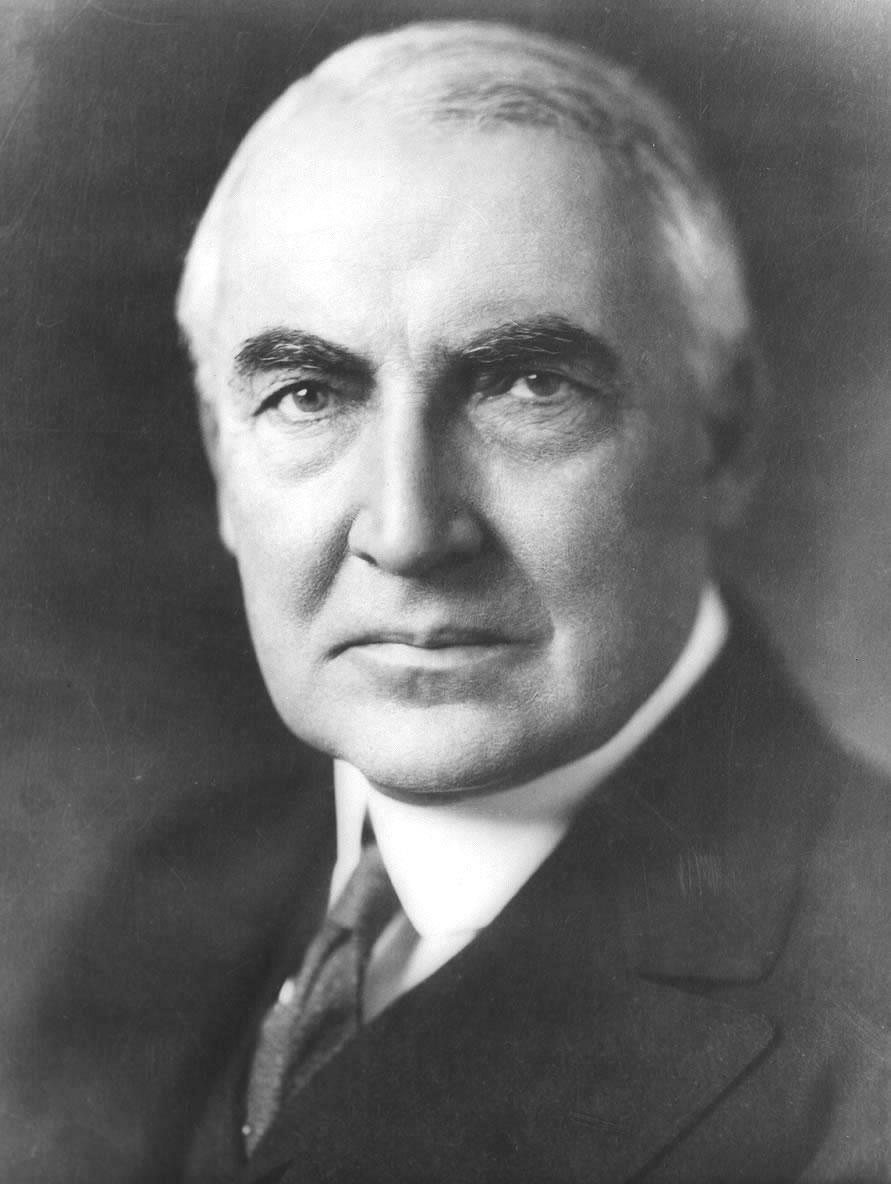
Warren G. Harding
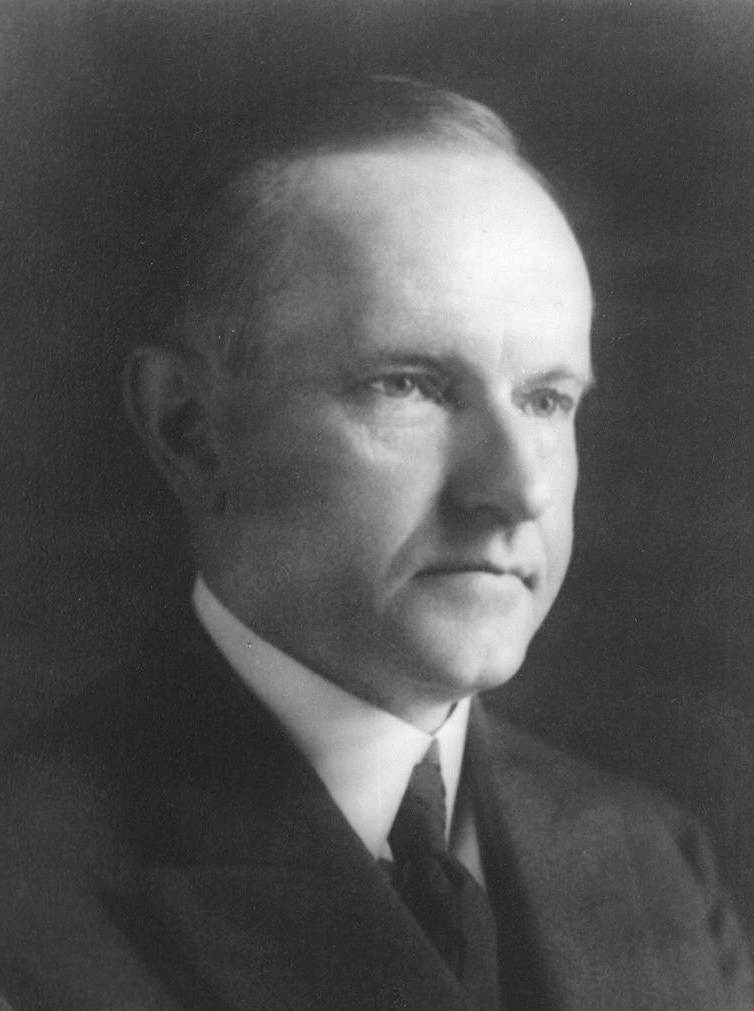
Calvin Coolidge
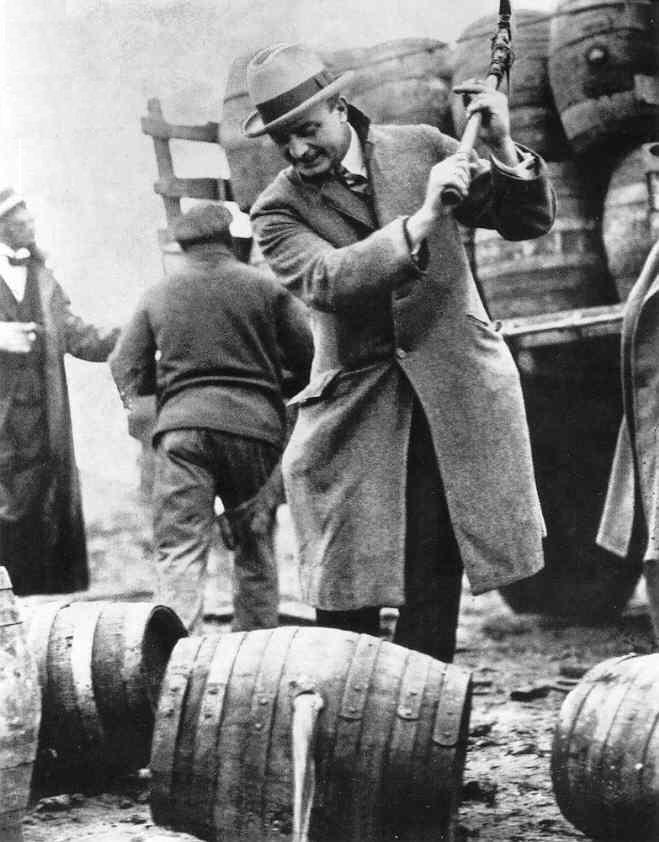
Destroying Beer -
1924
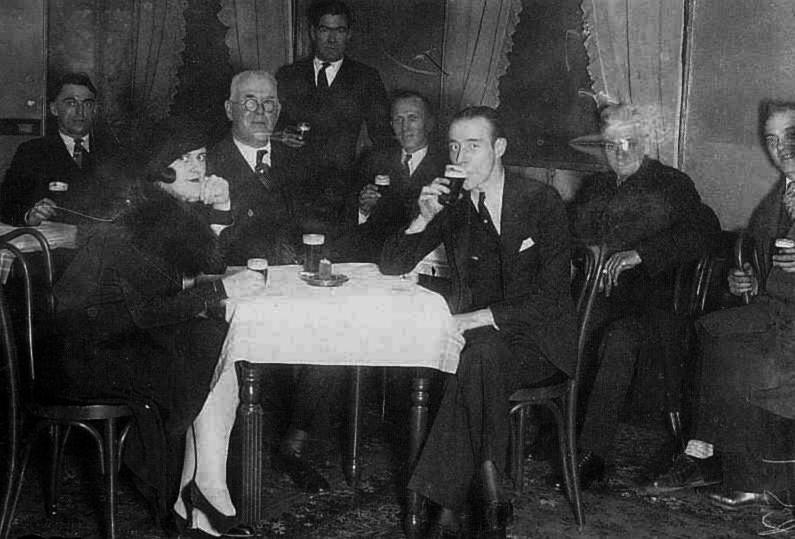 A 1920s
Speakeasy
A 1920s
Speakeasy
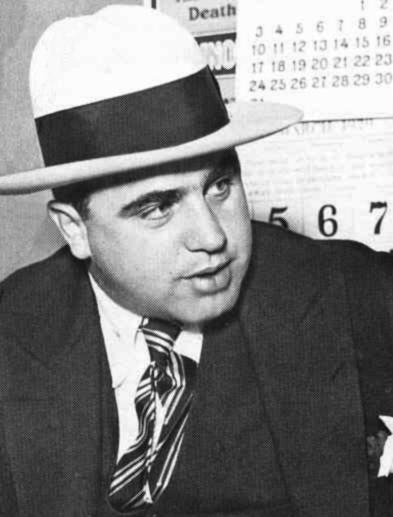 "Scarface" Al
Capone
"Scarface" Al
Capone
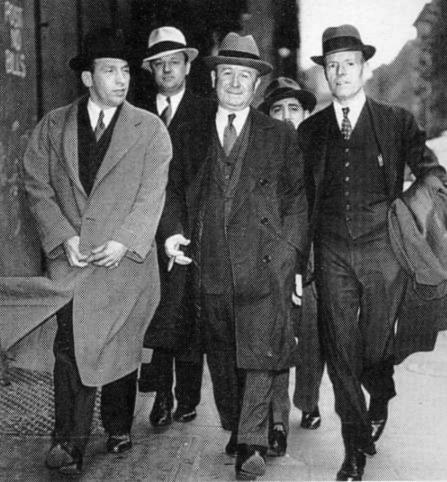
Johnny Torrio, Capone's mentor
in Chicago gang action – who subsequently retired and turned his operations over to Capone. He has just posted bail
on federal charges
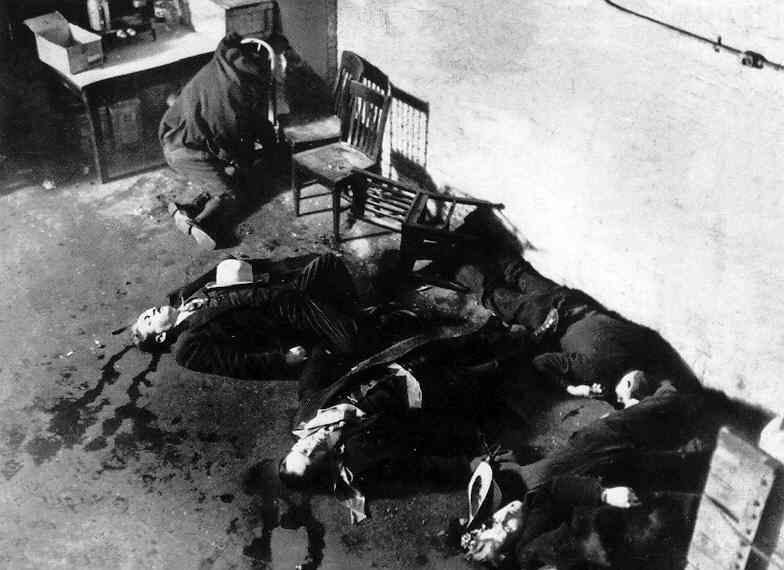
St. Valentine's Day massacre
of Chicago mobsters by enemy mobsters
THE SCOPES "MONKEY TRIAL" |
An
event occurred in Dayton, Tennessee, in 1925 – one that represented
very accurately the social-moral division digging deeply into American
society ... and for that matter much of the rest of post-war
Western society.
When the state legislature of Tennessee passed a law forbidding the
teaching of the Darwinist view of the origin of life, a group of local
town leaders decided to challenge the law ... as a way of bringing some
needed attention to their town. They had no idea of just how much
attention that would end up being. Immediately the very "Liberal"
America Civil Liberties Union (ACLU) decided to take up the cause in
defense of Darwinism,1
by bringing in the famous New York criminal lawyer, Clarence Darrow, to
argue their case. Brought in to represent the "Christian" or
Biblical stand on the matter was the old national political figure,
William Jennings Bryan. And the huge national press corps
gathered to watch the proceedings ... for the case truly represented
the very battle going on in America between the older Christian
worldview and the rising Secular-Humanist worldview, the latter
determined to challenge the Christian position in order to "progress"
America towards a more modern or "scientific" understanding of life and
its dynamics.
Which side actually won the case was hard to say ... for the case
itself decided very little legally. But it did highlight the
moral-spiritual crisis hitting Middle-America ... a traditionalist
sector of American society attempting to not be swept aside by the
rising Humanism worldview, the latter appealing to a much younger and
increasingly urban sector of American society.
1The
trial gets its name from Darwinism's claim that man was not make
complete in his present form at the dawn of history, but instead
evolved slowly over the eons from some primal ape or "monkey."
2Actually, Bryan's views were more "Centrist"
than "Fundamentalist." He was arguing on the basis of the moral
rather than scientific character of the case. His closing
argument (which had to be printed because closing arguments were not
allowed to be delivered) makes his case very clear:
| Science
is a magnificent force, but it is not a teacher of morals. It can
perfect machinery, but it adds no moral restraints to protect society
from the misuse of the machine. It can also build gigantic intellectual
ships, but it constructs no moral rudders for the control of
storm-tossed human vessel. It not only fails to supply the spiritual
element needed but some of its unproven hypotheses rob the ship of its
compass and thus endanger its cargo. In war, science has proven itself
an evil genius; it has made war more terrible than it ever was before.
Man used to be content to slaughter his fellowmen on a single plane,
the earth's surface. Science has taught him to go down into the water
and shoot up from below and to go up into the clouds and shoot down
from above, thus making the battlefield three times as bloody as it was
before; but science does not teach brotherly love. Science has made war
so hellish that civilization was about to commit suicide; and now we
are told that newly discovered instruments of destruction will make the
cruelties of the late war seem trivial in comparison with the cruelties
of wars that may come in the future. If civilization is to be saved
from the wreckage threatened by intelligence not consecrated by love,
it must be saved by the moral code of the meek and lowly Nazarene. His
teachings, and His teachings alone, can solve the problems that vex the
heart and perplex the world. |
Sadly, five days after the close of the case, Bryan died in his sleep while on another speaking tour.
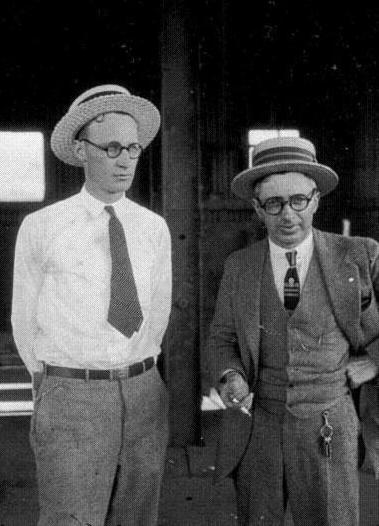 John Thomas Scopes (left) and George
Washington Rappleyea (right) - Dayton, Tennessee, June 1925
John Thomas Scopes (left) and George
Washington Rappleyea (right) - Dayton, Tennessee, June 1925
Smithsonian Institution
Archives
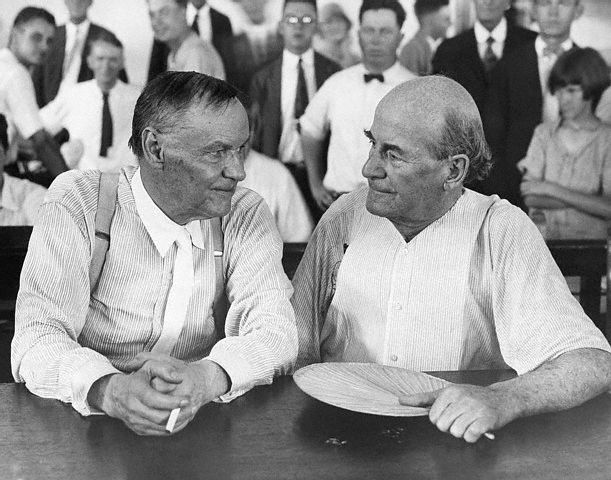 Clarence Darrow and William
Jennings Bryan in Dayton, Tennessee - 1925
Clarence Darrow and William
Jennings Bryan in Dayton, Tennessee - 1925
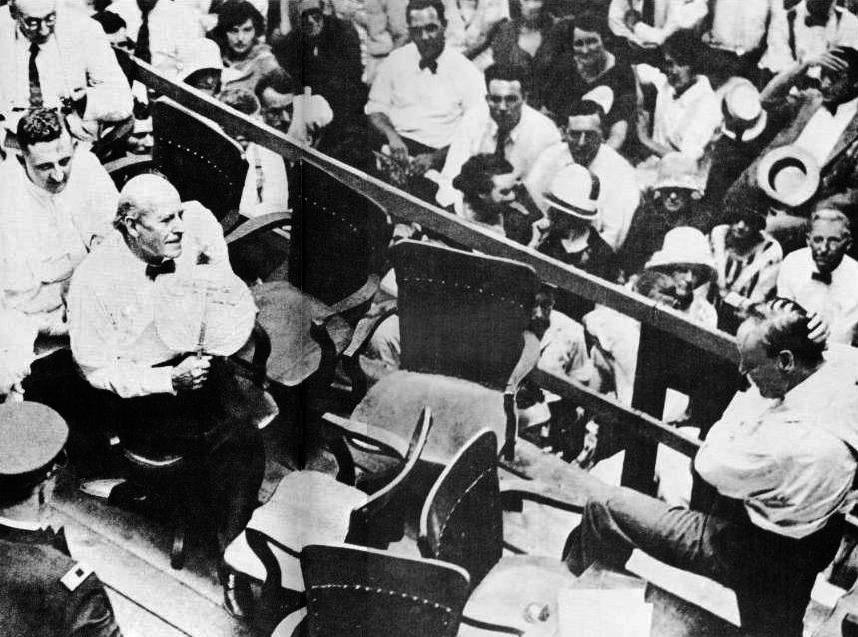 William Jennings Bryan under
examination by Clarence Darrow
William Jennings Bryan under
examination by Clarence Darrow
PARTICIPATING IN
THE WORLD DISARMAMENT MOVEMENT |
The
general view of the times, both in America and Europe, was that the
greatest danger to the peace that the world craved so deeply was to be
found in the heavy militarization of the nations. "Take the
weapons away and the nations will be forced to act peacefully with each
other." This huge Humanist hope seemed very logical, especially
when the nightmare of the Great War was still deep in people’s thoughts.
When Germany was forced to agree to a huge cutback in its military as
required by the Versailles Treaty, the Germans were led to believe that
this was not intended as punishment but instead as the first step in a
larger disarmament of all nations. On that basis the German
negotiators seemed to be accepting of the disarmament terms imposed on
them.
The Washington Conference (1921)
Toward that end America moved to host a disarmament conference in at
its capital in 1921. The Washington Conference brought
participants to agree on the outlawing of poison gas ... and also the
limiting of the building of naval vessels at a ratio of 5:5:3 for
Britain, America and Japan, these numbers reflecting the relative size
of each nation’s maritime activity. But beyond this naval accord
the powers were not willing to go ... France being especially nervous
about reducing its military in the face of a Germany that would surely
one day rebuild. Subsequent protests from the Germans that no
serious moves were being made to bring other countries in line with
Germany’s level of forced disarmament ultimately fell on deaf ears.
The Locarno Conference (1925)
Instead another approach was made to the ideal of world peace. In
1925 Germany was admitted to the League of Nations – recognizing it as
a major power with a permanent seat on the League Council ... and in
that same year it was a major participant at a diplomatic conference
held in the Swiss Alpine city of Locarno. The Locarno Agreement
contained the promise of France, Britain, Germany, Italy and Belgium
that they would not resort to war in their relations with each other
... but would resolve their conflicts only by peaceful means.
Locarno thus gave hope that Europeans might be ready to move to more
serious thoughts on military disarmament.
The Kellogg-Briande Pact (1928)
In 1928 American Secretary of State Frank Kellogg met with French
Foreign Minister Aristide Briand and signed a pact agreeing to renounce
war as a means of settling conflicts and to use peaceful means
instead. Soon the Kellogg-Briand Pact was joined by 59 other
nations (including Germany, Italy and Japan) – seemingly indicating
that the world was finally coming to its senses. Never again
would a war such as what the world had gone through ten years earlier
ever have to happen again.
Yet all of this was simply humanistic illusion ... as events would soon
prove. Serious conflicts of interest (such as contested
boundaries and revanchist dreams of gathering nationals scattered in
neighboring countries) were never really dealt with ... nor could they
be by peaceful means in any case. Too much was at stake for
nation-states not to attempt the use physical force if push came to
shove. And it soon did.
But in the meantime, those still shocked by the trauma of the Great War
were happy to believe that they had solved rationally one of life’s
most critical problems ... forever.
|
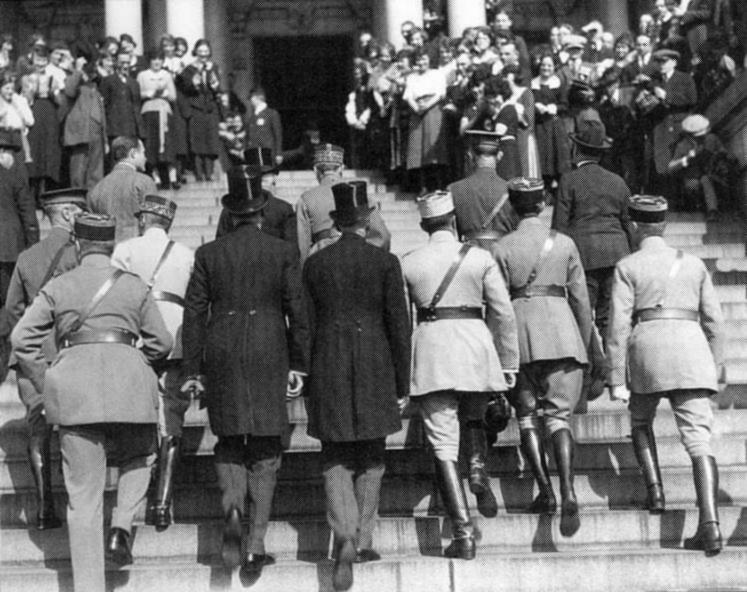
Europeans ascending the steps
to the U.S. State, War and Navy building in 1921 - to begin the Washington
Naval Conference designed to set limits on naval fleets
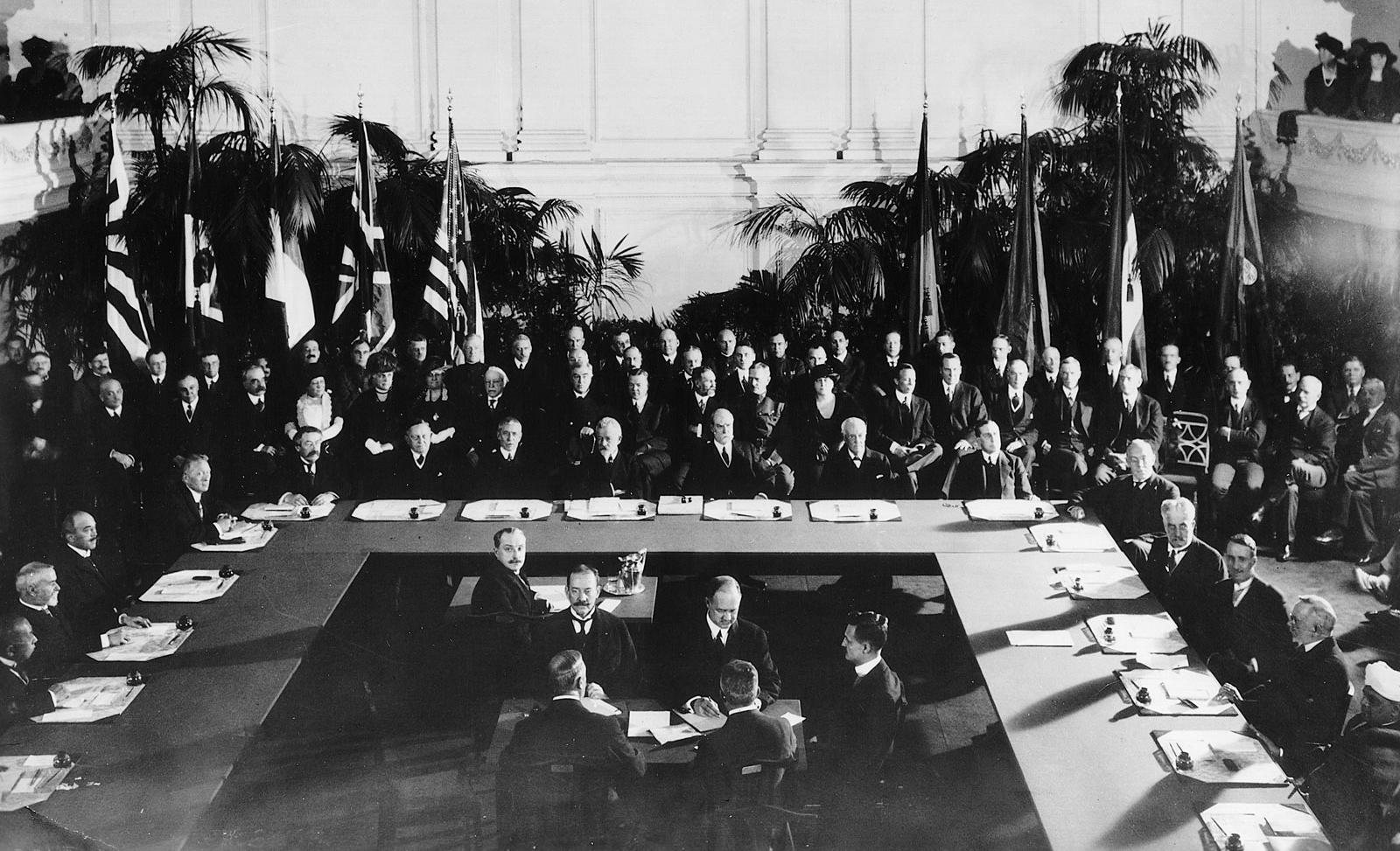
Delegates of the nine nations
participating in the Washington
Naval Conference - 1921-1922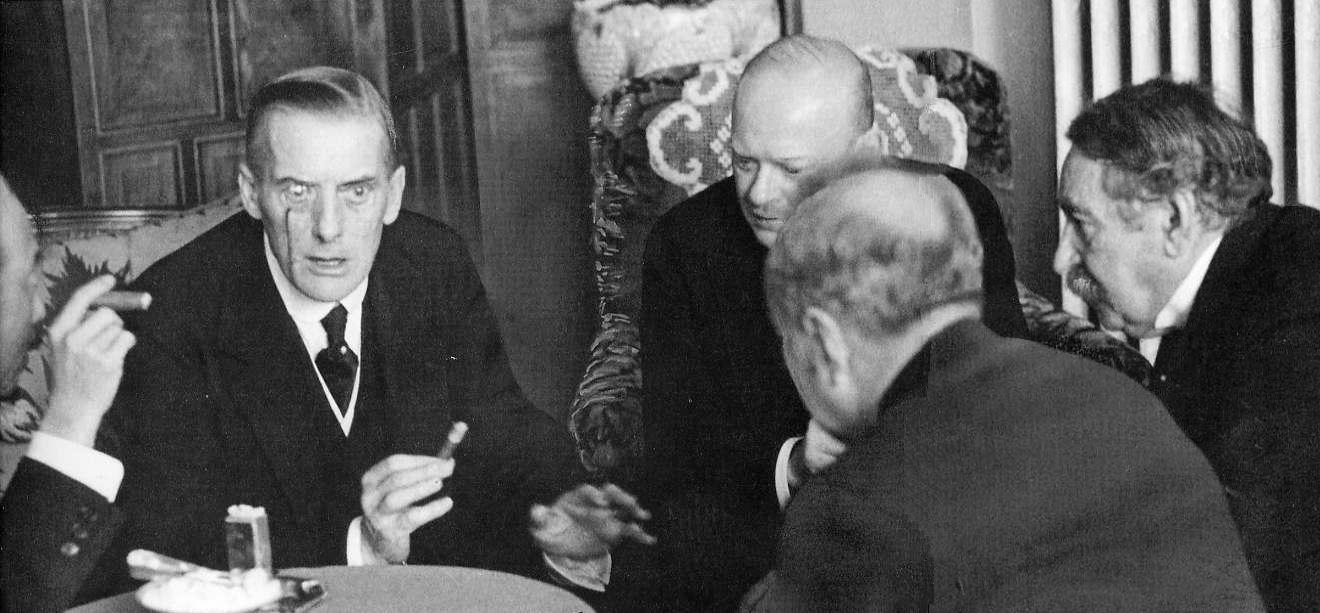
The diplomatic meeting at
Locarno, Switzerland - October 1925
|
The monocled British
diplomat Austen
Chamberlain meeting with European diplomats (French Foreign Minister Aristide
Briand is at the right) to "outlaw war" - through a series of treaties
recognizing the inviolability of European borders (with the notable exception
of Russia, whose borders were still in dispute). |
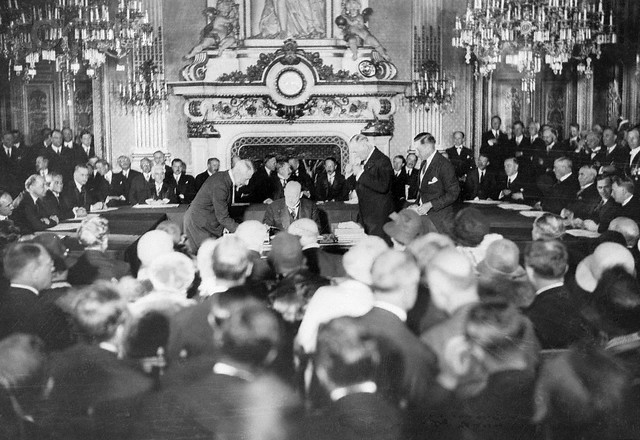
The signing of the Kellogg-Briand Pact outlawing
war - at the Palais D'Orsay in Paris - August 27,
1928
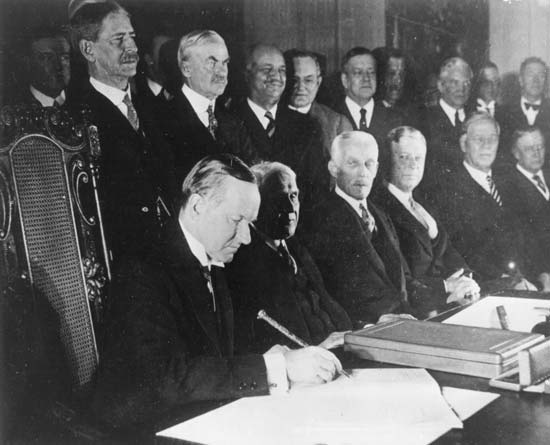
U.S.
President Coolidge signing the Kellogg-Briand Pact - January
1929

Go on to the next section: The Emerging Realm of Quantum Mechanics
 Miles
H. Hodges Miles
H. Hodges
| | |


 Disillusionment with "Old World" Europe
Disillusionment with "Old World" Europe
 Participating in the world disarmament
Participating in the world disarmament

























